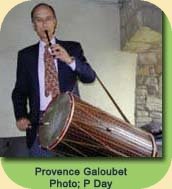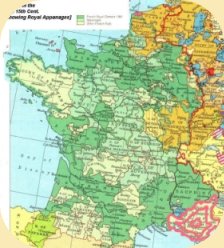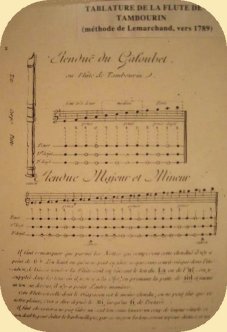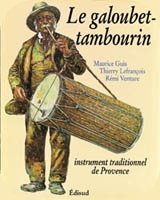A Short History of The Galoubet/Tambourin in Provence, France
A Short History of The Galoubet/Tambourin in Provence, France
by Nick Blanton
 |
click for music Les Jardinières
In the Middle Ages and Renaissance the pipe and tabor tradition extended over most of western Europe; Provence, a region of France, was no exception. During the 18th century these instruments evolved into the galoubet (pipe) and tambourin (drum) that continue to be played today.
Initially various sizes of drum (tambourin) were played. By the middle of the 18th century the long tambourin had become the usual drum in Provence and by the later 18th century the tuning of TTT had become most common for the galoubet. The tuning of what became the galoubet was the common TT 1/2T of the tabor pipe.
The galoubet and tambourin (along with the hurdy-gurdy and bagpipe) were adopted for fashionable high-class genteel pastoral entertainments across France during the18th century. However, over time they became more and more a feature of Provence, in the extreme south-east of the country. Here weddings, dances and festivals typically had one or more tambourinaires. The galoubet was developed so it could be played chromatically with a fairly wide register (audio here) and so was able to play the sophisticated marches, minuets and contredanses published and distributed throughout the region. For museum examples from 18th century onwards [search for galoubet].
In the mid 19th century there was a whole Provençal cultural revival, notably in urban areas such as Marseille. So the galoubet/tambourin repertoire acquired the, then, popular dance music of polkas, waltzes and the often complex and arpegiatted styles. These are still popular today. Example from an 1864 music book. This is a Rigadon from 1830.
At present there is another revivial. The instruments are taught in numerous schools and there is a yearly festival in Aix-en-Provence. [click the blue button at the bottom of the Aix-en-Provence page for mixed ensemble music]. The repertoire has broadened to include much early music, like the 16th century noëls in the collection of Notre Dame des Doms in Aivignon, and modern compositions. Maurice Guis, amongst others, has created music for ensembles and for galoubet/tambourin and piano. Electric bands mix galoubet/tambouri, or galoubet on its own with electric bass, guitar, synth and drum kit to create a strong Occitan / Provençal identity.
So in the 21st century there is again a diversity of sizes of instrument. Generally the most common galoubet for ensembles is that tuned TTT, starting on C5. Possibly the next popular is a lower one tuned TT 1/2T, starting on G4. But go here to see varied styles of tambourin, scroll down the page.
modern statuette by Gérard Lami
The tradition is kept alive also through the galoubet discussion site, French-speaking
References:
'Le Galoubet-Tambourin - Instrument traditional Provence', by Guis M., T. Lefrancois, R. Venture, 1993
The history of galoubet-tambourine-type instruments of the musical tradition of Provence. This book highlights both the instruments themselves and their factors, their repertoire and instrumental practice of the classical period to today. It just as useful for learning about the folk traditions of Provence as for specialists. ISBN 2-85744-687-XEdit and additions by Frances November 2009
top of page


